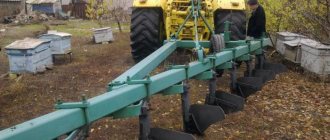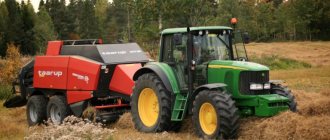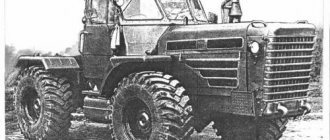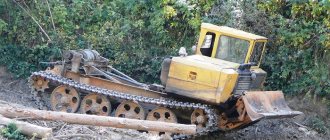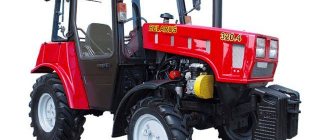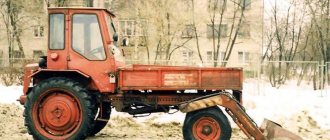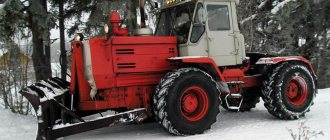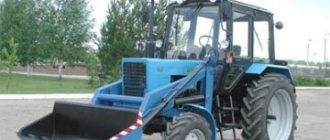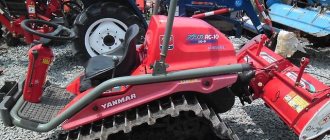During its operation (since 1931), the Tractor Plant in Kharkov has produced many machines that were, in their time, advanced models of agricultural machinery. These include the highly productive and efficient T-150 tractor on caterpillar tracks and the T-150K – a modification on wheels.
Structurally, both cars are as unified as possible and differ in their chassis and transmission at the final stage. Both versions are general purpose tractors and have a traction class of 3 tf (30 kN).
The technical solutions incorporated into the car by the designers more than 40 years ago turned out to be successful. Over the past time, the tractor not only has not lost its relevance, but has become one of the main machines in agricultural production.
This is especially true for the T-150K tractor, developed on the basis of its tracked brother and released 5 years later. Today, in addition to agriculture, it is used in the army and in construction. The machine, equipped with a blade at the front, is successfully used in winter for clearing snow at utility companies in many cities.
Modifications
The 150 series tractor today has four modifications, all of which belong to the T-150K model.
At its base, an army version of the T-154 was produced, with the help of which they carry out engineering and construction work and tow non-self-propelled artillery installations.
Differences from the base model include the presence of a tow hook instead of a pendulum linkage, the possibility of pre-heating the engine, and a higher travel speed. In addition, the rear half-frame is made elongated and carries a cargo body.
The modified T-156 machine is equipped with a bucket and is capable of performing loading work, and the LT-157 is a skidder and is used in logging.
The machines of the Kharkov plant were the basis for the development by the Rybinsk plant of a single-axle tractor operating as part of self-propelled scrapers and asphalt rollers. Its rear frame was replaced with the frame of the corresponding vehicle and the hinge between the half-frames was modified.
Design
The car has a front engine. The gearbox is rigidly attached to its rear part, and a cabin is installed on it, complete with a fuel tank with a capacity of 315 liters.
The gearbox can include transport, traction (slow), work mode and reverse. Gear shifting (there are 4 in total for each mode) is carried out by hydraulic couplings without stopping, under load and in motion.
The chassis is based on a supporting frame, which includes two longitudinal channel spars, which are transversely connected by a front and two intermediate steel beams. The turning control of the tracked version of the vehicle is steering. It also features the ability to have different gears on each track. This allows you to turn the car almost on the spot.
In the wheeled version, the unit has a frame of two parts, hingedly connected with the ability to rotate in a horizontal plane. The front frame carries the engine, gearbox, cabin and refueling tank. The other part is equipped with a hinged system designed to secure tools. The rear and front axles of the tractor are driven (the rear axle can be disconnected).
Description of the tractor model T-150
The car has a front engine. The T-150 tractor is a general-purpose crawler tractor. The engine has a power of 150 hp, it is possible to install a more powerful engine. Closed cabin type, with functioning ventilation and heating.
A windshield blowing system is installed. On the outside of the cabin there is a sun visor, windshield wipers, and rear-view mirrors.
Also in the cabin there are: two seats, the driver's seat can be adjusted depending on the height and weight of the driver, a thermos, a first aid kit, a coat hook, rubber mats and lighting is provided.
The caterpillar track of the T-150 tractor consists of 47 links, pitch 175 mm, located on the supporting frame. The control of the tracked version is steering.
Air cleaning of the engine is a two-stage process. The gearbox is mechanical and operates in four modes:
- working row;
- transport row;
- reverse;
- diminutive.
You can buy a T-150 tractor either used or new; of course, the price will differ significantly.
Review of the T-25 tractor and its technical characteristics.
By looking here you can watch a video of the MTZ-80 tractor.
This link will tell you all about the biggest tractors in the world.
Engine SMD-60
All modifications of tractors are equipped with diesel six-cylinder four-stroke supercharged SMD-60 engines with a 150-horsepower rated power. They were developed specifically for these machines, have a V-shaped arrangement of cylinders and liquid cooling.
The engine start is double: from the cab, using an electric starter, a starting gasoline engine is started, which serves to spin up the main unit. The T150 tractor is equipped with a three-stage system of highly efficient air purification supplied to the fuel system. It consists of an inertial oil (fine filter), two-stage (has ejection removal of settling dust) and a dry cyclone filter.
To make it easier to start the engine at temperatures below -5ºС, a pre-start heater PZHB-300 is provided.
Transmission
The transmission of tractors is mechanical, equipped to engage gears with hydraulic clutches. The designs of the gearboxes are unified, the main gears are made in the form of planetary gearboxes.
In the tracked version of the T-150, the gearbox is dual-flow, with the ability to transfer movement to the selected track.
In a wheeled unit, the torque is transmitted to the drive axles from the gearbox through the transfer case. The gearbox is also equipped with a power take-off shaft, which drives the mounted implements.
Chassis
The tracked vehicle is moved by two track chains, each of which is mounted on two sprung suspension balance carriages and two support rollers. The propulsion system is equipped with coil springs and hydraulic shock absorbers designed to reduce shocks from hitting obstacles.
The wheeled version is implemented with four wheels, one on each side of the front and rear axle. The tires installed on the tractor are wide, which reduces the pressure from its weight on the ground. All four tires are the same, models FD-14A or FD37 and are marked 530R610(21.3R24) and 610R655(23.1R26), respectively.
Technical characteristics of the T150-05-09 tractor
| Dimensions and weight | |
| Tractor weight, kg | 8150±2,5% |
| Length without hitch (with tow hitch), mm | 5000±50 |
| Width, mm | 1880±30 |
| Height, mm | 2680±40 |
| Base, mm | 1800 |
| Track, mm | 1435 |
| Ground clearance (not less) mm | 300 |
| Engine | |
| Model | YaMZ-236 |
| Rated power, kW (hp) | 128,7 (175) |
| Maximum torque N.m (kgf m) | 716 (73) |
| Number and arrangement of cylinders | 6, V-shaped |
| Cylinder diameter/piston stroke, mm | 130/140 |
| Working volume, l | 11,15 |
| Rated rotation speed of the diesel crankshaft, rpm | 2100 |
| Starting system | electric starter |
| Specific fuel consumption No at rated power, g/kWh (g/l.h.) | 220 (162) |
| Transmission | |
| Clutch: | dry, double-disc using a pressure disc with a YaMZ casing |
| Gearbox: | mechanical, switchable on the fly under load within each range |
| Number of ranges/forward gears: | 3/9 |
| Number of ranges/reverse gears: | 1/3 |
| Travel speeds, forward km/h | |
| I range | 4,26-5,88 |
| II range | 6,72-9,28 |
| III range | 11,09-15,31 |
| Travel speeds, reverse km/h | 5,74-7,93 |
| Pushing force in bulldozer mode | 5000 |
| Refill containers | |
| Engine oil, l | 25 |
| Gearbox oil, l | 38 |
| Oil in drive axles, l | 34 |
| Oil in the hydraulic system of the attachment, l | 38 |
| PTO gearbox oil, l | 6 |
| Fuel, l | 330 |
| Coolant, l | 30 |
| Coolant type | antifreeze or water |
More details about the device can be found in the operating instructions T-150-05-09 and T-150K-09
Pros and cons of the T-150 tractor
Advantages:
- Reduced ground pressure;
- High percentage of passability;
- Low fuel consumption;
- Ease of operation;
The disadvantages include the kinematic method of rotation. Rarely used, because it is too small, only 10 meters, but about 30m is needed. To increase the turning radius, you need to put more effort on the steering wheel, as a result of which the driver gets tired faster.
Video of the T-150 tractor in action.
Prospects in the modern market
The machines, despite the abundance of similar foreign equipment on the market, find interested buyers and continue to work in many areas of production. Of course, the technical characteristics of the T-150 cannot be called outstanding these days, but the affordable price, huge secondary market and ease of maintenance make many people choose it.
| T-150K | |
| Issued, gg. | since 1971 |
| Manufacturer | JSC HTZ |
| Purpose | general purpose |
| Propulsion type | wheeled |
| Traction class, tf | 3 |
| Theoretical forward/backward speeds, km/h | 1,8 – 30,1 / 6,6 – 10,4 |
| Operating weight, t | 8 |
| Location | |
| Cabin: | average |
| Engine: | front |
| Main Dimensions | |
| Length, mm | 6130 |
| Width, mm | 2400 |
| Height, mm | 3195 |
| Base, mm | 2860 |
| Track, mm | 1860 and 1680 |
| Road (agrotechnical) clearance, mm | 400 |
| Engine | |
| Engine make | SMD-62, YaMZ-236 |
| Transmission | |
| Transmission type | Hydro-mechanical |
| Suspension and handling | |
| Suspension type | The front axle is mounted on springs, the rear axle is rigidly attached to the frame |
| Rotation control method | by rotating the front and rear semi-frames around the vertical hinge |
| Brakes | working - shoes on each wheel, parking - belt on the front axle drive shaft |
| Equipment | |
| Hydraulic equipment | separate separate-aggregate system of the hitch, separate system for steering control, separate system for gear shifting. On tractors manufactured after 2013, the hydraulic systems of the hitch and swing are combined |
| Pneumatic equipment | control of the clutch, tractor and trailer brakes |
| Electrical equipment | on-board network with voltage 12 V |
| Media files on Wikimedia Commons | |
T-150K
- a Soviet agricultural energy-rich general-purpose wheeled tractor produced by the Kharkov Tractor Plant named after Sergo Ordzhonikidze. At the same time, the T-150, the most unified agricultural, energy-rich general-purpose crawler tractor, is being produced. They differ in chassis systems, turning mechanisms, frames, gearboxes (unified by element) and control systems.
Creating a family of unified wheeled and tracked tractors turned out to be a very difficult task. Currently, the famous John Deere company is following this path (for example, John Deere 8120 [1] and John Deere 8120T [2]). Historically, the wheeled version (T-150K) of the tractor was made earlier and became much more widespread. The T-150K tractor is a modernization of the T-125 tractor, the design of which is completely original and has no predecessors. In 1979, the T-150K tractor was successfully tested at the international testing site of the University of Nebraska, USA. The T-150K tractor has been in production for more than forty years, has undergone several modernizations, the technical characteristics given in the article refer to 1975.
Design features [edit | edit code ]
On the T-150K tractor the engine is located at the front. A clutch, gearbox and transfer case are attached to it, two output shafts are connected by cardan drives to bevel final drives installed in the rear and front axles. (The cardan drive to the rear axle contains an intermediate support). The differentials of the main gears are connected to planetary final drives, on which wheels with brakes are installed. Drive from the engine to the independent rear PTO is provided by a shaft running inside the tubular shafts of the clutch, gearbox and transfer case, and then by a driveline with an intermediate support. Intermediate supports ensure alignment of the symmetry axes of the double cardan forks with the axis of the vertical hinge, which allows the cardan gear angles to be kept to a minimum when turning the tractor. The tractor is rotated by two hydraulic cylinders that rotate the semi-frames relative to the vertical hinge.
technical characteristics: Gearbox of the T-150 tractor
The T-150 gearbox is designed to change the speed of the tractor and provides twelve forward speeds (three ranges of four speeds each) and four reverse speeds. The first and second speed ranges ensure work with non-motorized combines and all agricultural machines, the third range - with trailers and semi-trailers. The T-150K gearbox consists of two units: a gearbox and a transfer case, which are rigidly bolted to each other (Fig. 1). Rice. 1. T-150 gearbox with transfer case assembly 1 - movable front axle gear; 2 — front axle drive shaft, 3 — range reducer shaft; 4 — rear hydraulic clutch; 5 — front hydraulic clutch; 6 - secondary shaft; 7— gearbox hydraulic system distributor, 8— PTO drive shaft; 9 — input shaft; 10 — drive gear of 4th gear; 11 — drive gear of the 1st gear; 12 — drive gear of 1st gear; 13 — drive gear of third gear; 14 — range shift lever; 15— movable reverse gear; 16— reverse gear roller; 17 — locking mechanism for switching 1st range, 18 — lever for engaging the front post, 19 — lever for engaging the PTO drive, 20 — gear for driving the pumps and engaging the PTO; 21—drive gear of range III; 22 - drive gear of range II; 23 — transfer case input shaft; 24—gear range shift clutch; 25 — rear axle drive shaft. The T-150K gearbox is mechanical, four-speed with constant mesh gears and personal hydraulic clutches. Its housing contains: a primary shaft 9 with gears 10, 11, 12, 13 mounted on it and connected by involute splines to the clutch shaft; secondary shaft 6 with gears and hydraulic clutches 4, 5, shaft 3 of the first range gearbox with gears. The top of the housing is closed with a lid on which a filter and a bypass valve for the gearbox hydraulic system are installed. Gear shifting in the T-150 gearbox is carried out without interrupting the power flow by turning the distributor spool 7 using the hydraulic system. The distributor spool 7 has four fixed positions, each of which ensures that the corresponding gear is engaged. The design of the gearbox includes a locking mechanism that prevents the diesel engine from starting when the gear is engaged, as well as a locking mechanism 17, which makes it possible to switch ranges only when the main clutch is completely disengaged. Adjusting the mechanisms of the T-150K gearbox If you replace the bevel gears in the pump drive of the hydraulic system of the gearbox, adjust their installation correctly: by selecting gaskets, set the size to 42.5 ± 0'15 mm; by selecting gaskets when the roller with gears rests through the housing into the spacer housing, set the lateral clearance in the teeth of the bevel pair to 0.2-0.4 mm. Adjusting the range shift and reverse locking mechanism involves changing the length of the rod connecting the clutch control lever to the locking roller lever. Rice. 2. Adjustment of the T-150 gearbox range shift locking mechanism 1 - lever; 2 - finger; 3 - pointer; 4 - fork; 5 - lock nut; 6 - traction; 7 — clutch pedal. To change the rod length: — disconnect rod 6 (Fig. 2) from lever 1 of the locking roller; — fully depress clutch pedal 7; — install the locking roller so that the symmetry axis of the roller lever coincides with pointer 3 on the cover of compartment 1 of the range, and adjust the length of the rod by screwing or screwing on fork 4; — connect rod 6 to lever 1 and check the adjustment by turning on ranges I, II and III and the reverse range with the clutch pedal depressed. — cotter pin 2 and tighten locknut 5. Adjust the shift drive of the T-150 gearbox by changing the length of the rod connecting the shift lever to the distributor shaft lever. Rice. 3. Adjusting the gearshift drive of the T-150K gearbox 1 - distributor lever; 2 — rod, 3 — adjusting fork; 4 — gear shift lever. To adjust the shift drive of the T-150 gearbox, perform the following steps: - disconnect rod 2 (Fig. 3) from gear shift lever 4; — install the gear shift lever 4 so that the number “2” on the indicator is located against the arrow, set the gearbox distributor lever 1 to a horizontal fixed position (the axis of the lever must be parallel to the longitudinal axis of the gearbox); — by screwing or unscrewing fork 3 at the upper end of the rod, adjust the length of the rod; — connect the fork 3 of the link 2 with the gear shift lever 4. After adjustment, it may be necessary to reduce or increase the force on gear shift lever 4. The force is adjusted using an adjusting screw tightened with a nut. Disassembly and reassembly of components should only be carried out by qualified mechanics in a clean room. When disassembling, assembling and adjusting the components of the hydraulic system of the T-150K gearbox, follow the following rules: adjust the components using control devices; If it is necessary to disassemble and reassemble the distributor, do not allow the spool to be disassembled with the body, since they represent a plunger pair. When assembling, install the spool and sector according to the marks marked on the corresponding teeth and cavities of the ring gears. Incorrect installation leads to disruption of the hydraulic system. Disassembling the T-150K tractor gearbox. A stand is used for disassembly and assembly. Having installed the gearbox on the stand, remove its cover and the creeper cover and gasket. Having unlocked the row shift forks, speed reducer gears, reverse gears and the double driver and unscrewed the locking bolts, remove the rollers from the housing and remove the forks and driver. After unscrewing the seven bolts securing the distributor to the gearbox housing, remove the distributor and gasket. Having disconnected the bypass pipe from the accumulator and the gearbox housing, remove the accumulator and gasket. Remove the fixing pin of the upper bearing cup from the gearbox housing, install a lock washer on this cup, insert a long extension inside the input shaft and, using the hydraulic clamp of the stand, press out the cup with ball bearing 210. Bending the edges of the lock washer from the edges of the nut, unscrew the nut from the threaded end of the primary T-150 gearbox shaft and remove the washer. Install a technological cup in the housing socket and, using special attachments, press the input shaft with the upper cup and ball bearing 313 out of the housing. Remove the third gear drive gear, spacer sleeve, second gear drive gear, first gear drive gear, bushing and fourth gear drive gear. Disassemble the input shaft by pressing off the upper cup assembly with the bearing, removing the shaft seal sleeve, and removing the retaining ring from the cup, removing the sealing ring and pressing out the ball bearing and oil seal. Bend the edges of the lock washer, unscrew the nut, unscrew the bolt from the end of the secondary shaft, remove the lock washers, the creeper gear, the drive gear and the bushing. Remove ten o-rings from the grooves of the secondary shaft. Install the device for removing and installing hydraulic clutches in a special mandrel and dismantle the secondary shaft assembly with bearing 313. Remove the hydraulic clutches and rings from the housing. Remove the pin from the T-150 gearbox housing, press out the lower bearing cup and the cup with ball bearing 311. Take out the retaining ring and remove the ball bearing from the lower cup. Press ball bearing 313 from the secondary shaft. To disassemble the creeper shaft, unscrew the nut, having previously bent the edges of the lock washer, remove the lock washer, locking ring and spacer washer from the creeper shaft. Using a technological bracket and a special attachment on the stand, dismantle the creeper shaft with ball bearing 50408. Remove ball bearing 408 from the housing, and press ball bearing 50408 from the shaft. Remove the small and driven gears and three spacer bushings from the creeper housing. Dismantling the T-150K gearbox speed reducer cover: — Remove the plug. — Remove the pointer and locking roller, the sealing ring from the locking roller, the rocker and the small column. — Remove the limiter and spring. — Remove the clamp and cover from the column, dismantle the rivet securing the thrust bushing to the lever, remove the bushing, spring, cap and row shift lever. — Knock out the pin from the small column and press out the insert. Disassembling the T-150 gearbox cover: - Remove the filter, gasket, bypass distributor and second gasket from the housing cover. — Unscrew the two fittings and remove the sealing rings from them. — Disassemble the filter. — At the same time, remove the filter cover and gasket from the housing and unscrew the plug, remove the set of filter elements and the spring from the filter housing. — Unscrew the nut and bracket securing the thrust washer to the pipe. — Remove the thrust washer, spring, piston, ring, filter elements and second ring, and unscrew the valve body from the pipe. — Remove the spring and ball, and then the ring from the groove of the filter piston. Assembling the T-150K tractor gearbox Before assembly, all parts of the gearbox are thoroughly washed and dried, and the channels are purged with compressed air. The rubbing surfaces of the parts are lubricated with engine oil. First, large assembly units are assembled. Assembling the T-150 gearbox cover: — Assemble the filter. — Install the spring and ball into the tube and screw in the valve body assembly. — Install the ring, 38 filter elements, the second ring, the filter piston, the filter spring and the thrust washer on the pipe assembled with the washer and secure it with a bracket and nut. — Install the piston ring onto the filter spring; — Insert a set of filter elements into the filter housing. — Install the gasket and filter cover on the housing; — Screw the plug into the filter cover. The filter assembly is tested, gradually increasing the engine oil pressure to 2.5 MPa (25 kgf/cm2). In this case, oil leakage is not allowed. Assemble the gearbox cover: install the bypass distributor and filter with gaskets and screw two fittings with O-rings into the cover. Before assembly, the gaskets are lubricated on both sides with sealing grease. All nuts and bolts are tightened securely. Assembling the T-150 gearbox creeper cover: — Press the insert into the small column and secure it with a pin. — Install the row shift lever in the column, and on it a cap, a spring and a thrust fork, securing it to the lever with a rivet. — Install the cover on the assembled small column, securing it with a clamp. — A spring and a limiter are inserted into the cover of the T-150 creeper. — The limiter must be fixed by the projections of the slide and move freely. — The assembled small column and the rocker are secured to the speed reducer cover, having previously installed the gasket. — Install the sealing ring on the locking roller, insert the roller into the cover, secure the indicator with a bolt and screw in the plug. — The locking roller should rotate freely by hand. General assembly of the T-150 gearbox The splines of the clutch drum and the spline bushings of the hydraulic clutches are aligned using technological spline rollers. Then both couplings are fixed in a device for removing and installing couplings. The splines of one coupling are aligned with one elongated splined technological shaft. A set of couplings with a process shaft and rings is installed into the T-150K gearbox housing using a device. Press the lower bearing cup into the gearbox housing and secure it with a pin. Press ball bearing 311 into the lower cup and install retaining rings. Press the lower cup with ball bearing 311 simultaneously into the housing and onto the secondary shaft, having previously pushed the process shaft out of the hydraulic clamping couplings with the secondary shaft. Press in ball bearing 313 and, if necessary, press in the shaft.
Rice. 4. Installation of T-150 hydraulic clutches The couplings on the shaft are installed so that the arrow on the rear coupling and two arrows on the front coupling are directed along the tractor and are located at the top, and the arrow on the end of the shaft is directed upward (Fig. 4). The lower glass is pressed into the gearbox housing so that the groove of the glass coincides with the mark on the housing. Install the speed reducer drive gear, the speed reducer engagement gear, a special bushing, lock and lock washers on the secondary shaft, tighten the nut and screw in the bolt. Ten sealing rings are installed in the recesses of the secondary shaft of the T-150 gearbox. The secondary shaft with couplings must rotate freely in the bearing without jamming. Press the ball bearing 50408 onto the speed reducer shaft, install a ring on the bearing, and a spacer washer and a retaining ring on the shaft. The assembled shaft is passed into the housing hole, installing a small speed reducer gear, two bushings, a driven speed reducer gear and a bushing on it. Using the stand's hydraulic bracket, technological bracket and special attachments, press the speed reducer shaft with ball bearing 50408 into the housing, and ball bearing 408 onto the shaft and into the housing at the same time. Install a lock washer on the creeper shaft, tighten the nut and bend the edges of the lock washer onto the edge of the nut. The input shaft of the T-150K gearbox is assembled and installed in the following order: - Press the ball bearing 313 into the upper cup. — Install the retaining and sealing rings, frame oil seal and oil seal bushing, press the upper cup onto the input shaft. — Insert the shaft into the housing while installing the fourth gear drive gear, spacer sleeve, first gear drive gear, second spacer sleeve and third gear drive gear. — Using the hydraulic bracket of the stand and special attachments, press ball bearing 311 onto the input shaft. — Install the lock washer, tighten the nut until it stops and bend the edges of the lock washer on the edge of the nut. — Press the upper bearing cup simultaneously onto the ball bearing 311 and into the housing, having previously pressed the ball bearing 210 into the cup and installing the retaining ring. — Install the pin into the T-150 gearbox housing and the upper bearing cup. The lateral clearances between the teeth of a pair of cylindrical gears of any transmission should be within 0.2...0.5 mm. The input shaft with gears must rotate freely in the bearings without jamming. Install and secure the gearbox cover, hydraulic accumulator and distributor with gaskets. Install the rollers, double driver, row shift forks, reverse gears and speed reducer gears, locking them with bolts and locking them with wire.
Remspetsmash LLC sells, repairs and exchanges gearboxes for the T-150 wheeled tractor; you can learn more about how to place an order for the supply or repair of this gearbox by following this link
Interesting fact [edit | edit code ]
To clean the deck of the only aircraft carrier in the Russian Navy, the Admiral Kuznetsov, a T-150K tractor is used, on which the MiG-15 fighter engine is installed. The task of this unit, called TM-59, is to clear the deck of foreign objects by blowing it away with a jet from a jet engine [3].
Wheeled agricultural tractors of general purpose, traction class 3 tf are designed to perform energy-intensive agricultural work: plowing, continuous cultivation, harrowing, sowing grain and industrial crops, transport work with trailers with a carrying capacity of up to 20 tons.
- Technical characteristics of HTZ T-150K
The T-150K tractors are manufactured by OJSC Kharkov Tractor Plant named after. S. Ordzhonikidze.”
Contact information 61007 Ukraine, Kharkov, ave. Moskovsky, 275. Information desk, phone: +38
Technical characteristics of tractors T-150 and T-150k
Tractors were designed several centuries ago, and every year they have been modernized and changed.
Today there are two main types of vehicles: tracked and wheeled.
The T-150 tractor belongs to the first type; this model has a wheeled modification - this is the T-150k tractor.
Technical characteristics of the T-150k tractor
| Traction class | average |
| Engine power | 175 hp |
| Volume of the tank | 375 l |
| Weight | 7685 kg |
| Size | 5735 X 2400 X 2945 cm |
The characteristics of both tractors cannot be compared because they belong to different types.
Technical characteristics of the T-150 tractor
| Traction class | average |
| Engine power | 100-150 hp |
| Fuel tank volume | 315 l |
| Weight | 6970 kg |
| Size | 4935 X 1850 X 2915 mm |
| Maximum speed | 32 km/h |
